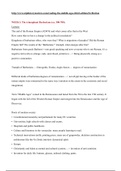http://www.utphistorymatters.com/reading-the-middle-ages-third-edition/#reflection
WEEK1: The triumphant Barbarians (ca. 300-700).
Lecture:
The end of the Roman Empire (AD476) and what comes after that in the West
How come that we have a change in the political consolation?
Kingdoms of barbarians tribes, who were they? What is migrations of peoples? Did the Roman
Empire fall? The results of the “Barbarians’” triumph, what emerges after this?
Barbarians from greek Barbaroi = non greek speaking and now everyone who is not Roman, it’s a
negative term (who is strange, rude, uncivilised, primitive) —> Being physically strong as a
positive connotation.
Trumph of Barbarians — Ostrogoths, Franks, Anglo-Saxon — degrees of romanisation
Different kinds of barbarians:degrees of romanization —> not all ppl leaving at the border of the
roman empire were romanised in the same way (variation in the extent in the economic and social
integration)
Term “Middle Ages” coined in the Renaissance and lasted from the 5th to the late 15th century. It
began with the fall of the Western Roman Empire and merged into the Renaissance and the Age of
Discovery.
Roots of modern society:
• Constitutional monarchy and parliament for many EU countries
• Universities, high schools with classes and exams.
• Hospitals and public healthcare.
• Culture and literature in the vernacular: many people learning to read.
• Technical innovations (mills, printing press, mass use of gunpowder, skeleton construction in
architecture like the St.-Denis interior): dynamical spirit.
• Europe.
• Christianity and Islam as mental and cultural systems —> invention of anti semitism.
• Invention for daily life: buttons, glasses, tailored clothing, pants.
, Stilicho — commander in chief of the Roman army around 400 but was a barbarian — married to a
Roman princess Serena and had a son Eucherius
—> What are “Migrations of peoples”? People started to migrate in 1st-6th centuries 1)seeking for
wealth 2) the arrival of the Huns in central Asia leading to a“Völkerlawine” “an avalanche of
peoples” (Herwig Wolfram) — ppl started running away, other cooperated with them —> migration
means moving from a place to an other in which some ppl stay while other leave, often changing
their names.
The Ostogoths —> originally locate in Ukraine and moved there as allies of the Roman Empire
then moved to Italy, south France, Hungary, Austria and created the Ostrogoths kingdom
• After 476 invasion of Italy at the request of the emperor in Byzantium
• Continuity of Roman administration and economy
• Christian religion, but Arian Christian
• Defeat by the armies of the emperor Justinian (553). Disappearance of the Ostrogoths
• Destruction and the arrival of the Lombards in Italy
The Franks:royal dynasty of the Merovingians
• Succesfull policy from their first important king onwards: Clovis
• Less romanized than Goths, but use of Roman institutions and administration; annexation of
Roman state properties
• military alliances with other groups or peoples in ongoing aggressive military campaigns: sharing
the spoils of war
• political alliances with noble factions; manipulating their opponents
• conversion to the “correct” Roman version of Christianity, as opposed to Arianism.
• Religion as legitimation of royal power
The British Isles and the Anglo-Saxons
• Britannia part of the Roman empire, border in the north: Hadrian’s Wall
• to the north “Picts”, Celtic tribes
• Romanized Celtic
• Christian religion
• Ireland: not part of the Roman empire, small Celtic kingdoms, converted to Christianity






